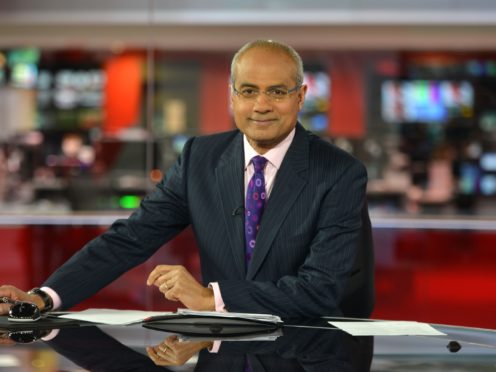George Alagiah has told of his guilt at using a disabled toilet when he was not visibly disabled but was having to use the facilities due to a stoma bag attached to his stomach.
Talking about living with a stoma for the first time, the BBC newsreader, who has stage four bowel cancer, also said that he had to get his suits for work altered to allow for the bag on his abdomen.
Alagiah, 63, underwent 17 rounds of chemotherapy to treat advanced bowel cancer in 2014 before returning to presenting duties in 2015, but in January 2018 he revealed that the cancer had returned.
The broadcaster previously underwent an ileostomy, where the small bowel is diverted through a stoma, an opening in the stomach.
A special bag is placed over the stoma to collect waste products that would usually pass through the colon.
Alagiah no longer has the stoma after undergoing reversal treatment, but he has spoken for the first time about the impact it had on his life.
In the podcast In Conversation With George Alagiah: A Bowel Cancer UK Podcast, he said: “I used to find difficult – I had a stoma but I didn’t look disabled, and I would be turning the key in a disabled loo in a motorway service station or something.
“And if there was a queue and somebody obviously disabled (was there), I used to feel guilty and feel like I needed to apologise and explain.
“The reason you need to go into a disabled loo is that you just need a little bit of space, to get the contents of your blue bag out and the sanitising equipment and so on.”
He revealed that he had to have his clothes altered for work due to the stoma bag.
Alagiah said: “As a man, and wearing a suit for work – when I’m not doing this, I’m reading the news for the BBC – I had to get my suits taken out and wear braces, and so on, because it was higher up.”
Of the concerns he felt, he said: “I (was) always looking around at my colleagues and thinking, ‘Can they smell anything, can they hear anything?’”
He added: “Before I was presenting the news, I used to be a foreign correspondent, and I used to have this bag, a satchel, which had everything I needed – at the drop of a hat I could get on a place and I knew I could do my work.
“And suddenly this blue bag (a stoma kit bag) became my new thing that I would take everywhere.”
He said that he used to find “the embarrassment factor too much” when going out for an evening due to the stoma bag, and that he would “load up” on Imodium to “slow it all down”.
Alagiah also told of how he did not want his wife to see his stoma, but that she had to help him after he first returned home from hospital as the bag had leaked.
“I remember thinking that I didn’t want my wife to see it, and what happened was, I got home, and for whatever reason, but it started leaking.
And a total privilege to record this with you @pouchcarenurse and @BBCAlagiah 🙏🏻 #stoma #thisisbowelcancer https://t.co/uyzHAqL8tY
— Andrea Robson (@andreakrobson) April 18, 2019
“I went back up to the bathroom to try and clean myself up – we had just sat down for what I hoped would be an intimate evening, we’d poured ourselves some drinks – and there I was, in the loo, this thing kept spurting out and my wife had to help me.”
Alagiah spoke to stage two bowel cancer sufferer Andrea Robson and her stoma nurse Lisa Allison, clinical nurse specialist in pouch care at Northwick Park and St Mark’s Hospital, about managing a stoma in the podcast.
The BBC journalist hosts the first series of Bowel Cancer UK’s podcasts, interviewing supporters and leading experts on the disease, as well as discussing his own treatment and diagnosis.
Bowel cancer is the UK’s fourth most common cancer and second biggest killer cancer with more than 16,000 people dying from the disease every year, the charity said.
But it is treatable and curable, especially if diagnosed early.
In Conversation With George Alagiah: A Bowel Cancer UK Podcast can be found at www.bowelcanceruk.org.uk/podcasts.
